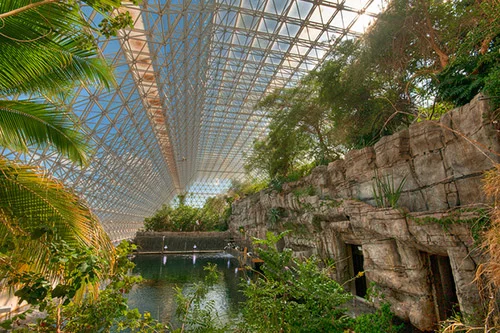(Photo: Getty Images)
By: Andrianna Veatch, Staff Reporter
These last few months have been afflicted with some particularly egregious global ecological disasters: Hurricane Harvey in Texas, Hurricane Maria in Puerto Rico, Windstorm Thomas in Central Europe, etcetera. There are times when it seems as though our own planet might turn against us, and there is little we mere mortals can do to stop it. However, much effort is being made to study these major changes in our ecology, and in the sand-swept desert of Oracle, Arizona stands one of the nation’s leading investigatory labs for ecological study: Biosphere 2.
Built between 1987 and 1991, Biosphere 2 was originally designed as an enclosed living environment to test whether humans could produce a sustainable atmosphere and survive in it. The test involved sealing eight human researchers into the 3.14 acreage greenhouse for two years, having them grow all their own food and maintain the literal miles of plumbing and design that kept Biosphere 2 running.
The project was plagued with misfortune from the get-go: the concrete from which the building was constructed absorbed over 75% of the researchers’ limited air; two monsoon years kept the skies cloudy and overcast, preventing the plants within the greenhouse from properly photosynthesizing. This limited the researchers’ food and air production and at the end of thirteen months, they were starving and suffocated. Oxygen had to be pumped into the Biosphere to keep them alive.
While the attempt of sustained survival was not as successful as hoped, Biosphere 2 has since been converted into a living lab to study ecological change. Within its rambling rooms are housed five biomes: a rainforest, desert, ocean, savanna, and mangrove. Its most major project is the Landscape Evolution Observatory, which—when completed—will provide valuable data on water erosion and methods to prevent it. Currently, much research is being conducted on rainforest drought, precipitation and CO2 levels in the hope of understanding the interactions and impact these three factors have on each other and the forests of Earth.
What Biosphere 2 has always been, however, is an example of good stewardship. It is our duty to learn about the miraculous and intricate systems by which we all live, and to protect and understand them. By knowing these things, events like Hurricane Maria and Windstorm Thomas can be calculated for and in time we can learn how to manage and defend against them. Stewardship is not just for scientists and researchers, though. Biosphere 2, as a public exhibit, reminds us that our efforts to protect Earth begin at home, be it desert or rainforest or city. Forewarned is forearmed, and Biosphere 2 produces date and information which we may apply to own lives, to protect this treasure known as earth.

